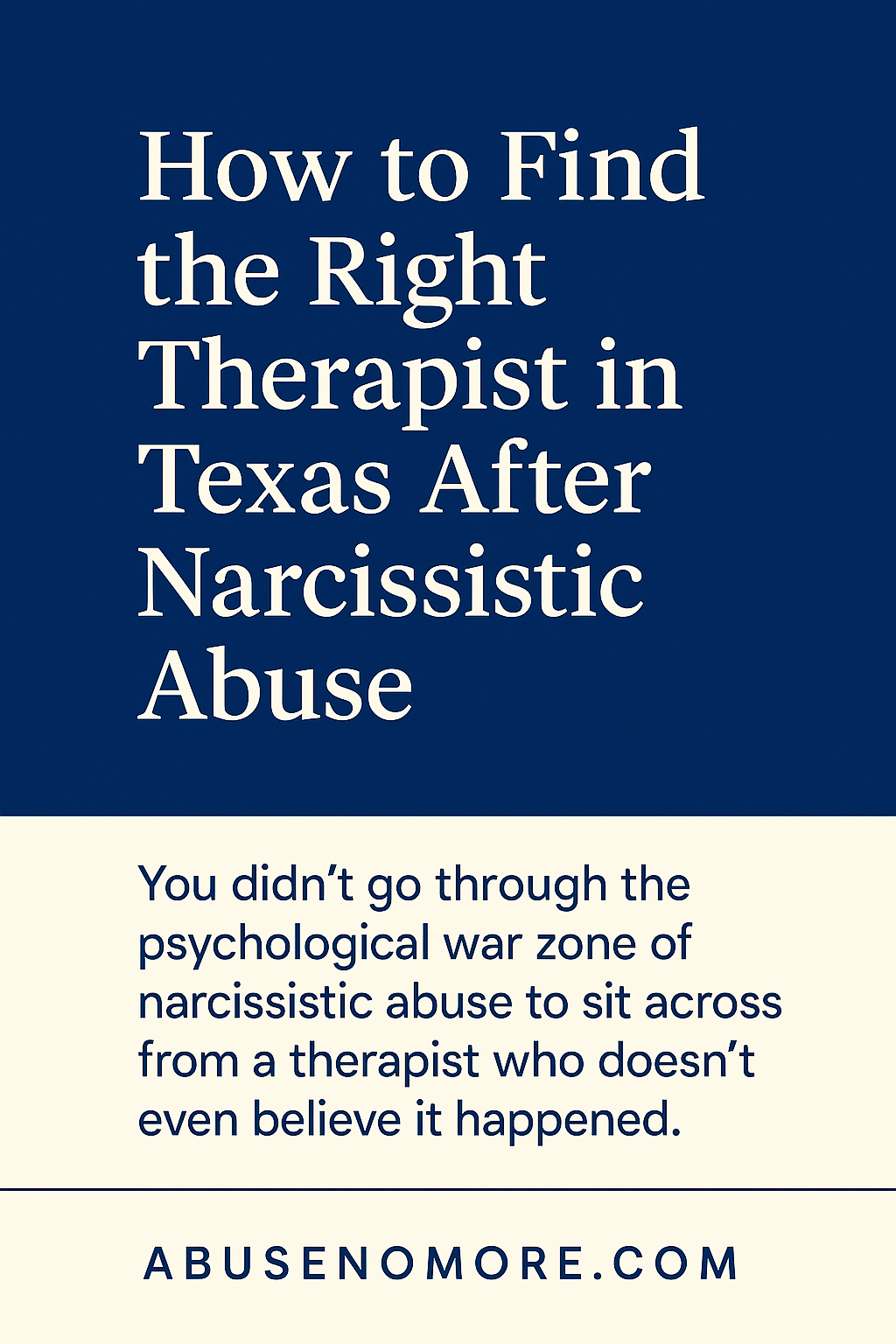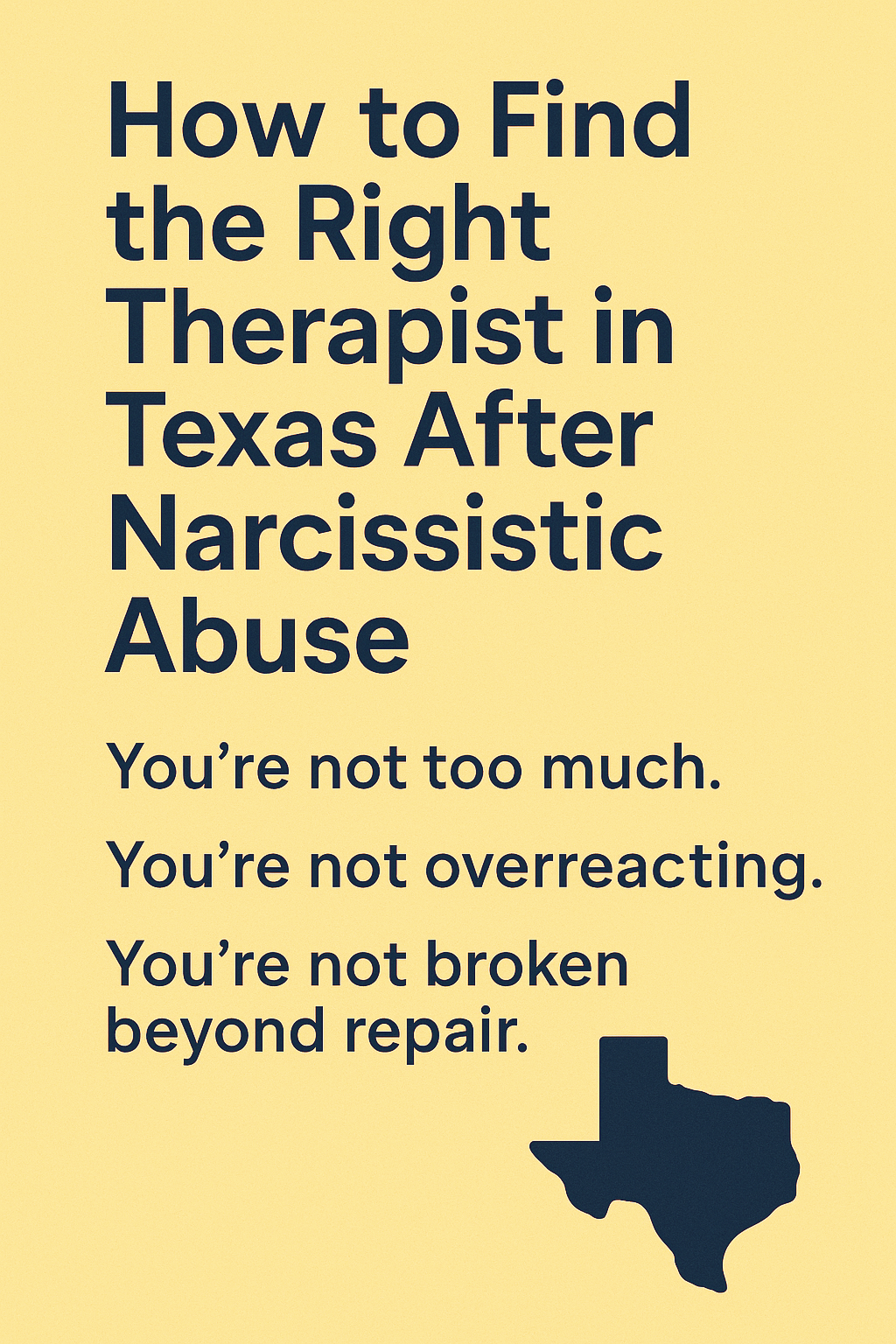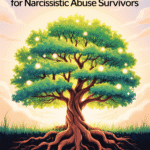Now Reading: How to Find the Right Therapist in Texas After Narcissistic Abuse
- 01
How to Find the Right Therapist in Texas After Narcissistic Abuse

How to Find the Right Therapist in Texas After Narcissistic Abuse
🧭 How to Find the Right Therapist in Texas After Narcissistic Abuse
The Search Is Different Here
You didn’t survive narcissistic abuse just to settle for a therapist who calls it a “communication issue.” You’re not just looking for help — you’re looking for someone who understands. Someone who won’t flinch when you say “gaslighting,” or imply that your trauma is just “relationship baggage.”
If you’re in Texas, that search comes with extra layers. Maybe you’ve tried therapy before and left feeling more confused than when you started. Maybe you live in a rural area where no one even talks about emotional abuse. Maybe you’ve been told to forgive and move on — before anyone even believed you.
This guide is here to change that. Whether you’re in Houston, Austin, Dallas, El Paso, or somewhere no one’s ever heard of, you deserve a therapist who sees what you’ve been through — and knows exactly how to help you rebuild.
Why This Matters in Texas
Texas is big. So is the silence survivors often face. In tight-knit communities, it’s common to be told to keep the peace, stay quiet, or protect the family name. In bigger cities, the issue becomes choice overload — thousands of therapists, but almost none explicitly trained in emotional abuse recovery.
That means survivors across the state — from the suburbs to the border towns — are walking around in chronic freeze mode, hoping that one more journaling session or podcast episode might be enough. And it’s not.
Not because you’re broken, but because the kind of trauma you endured — identity erasure, manipulation, psychological warfare — needs more than surface-level solutions. It needs a recovery process. One that starts with the right therapist.
What You’ll Find in This Guide
This isn’t a list of feel-good tips. This is a strategy. It’s written for people who’ve tried to explain what they’ve been through — and watched the listener’s eyes glaze over. It’s for survivors who aren’t just “working on boundaries,” but unlearning a whole system of internalized gaslighting.
Inside this article, you’ll find:
- A breakdown of how narcissistic abuse actually works — and why most therapists miss it.
- A set of 10 must-ask screening questions to help you filter out the well-meaning but misaligned professionals.
- A real-world look at Texas-specific therapy barriers: rural gaps, cultural denial, and telehealth challenges.
- A curated list of therapists who specialize in emotional abuse, C-PTSD, and nervous system recovery — not just generic mental health.
- Self-guided support options (books, nervous system tools, and survivor communities) for those who aren’t ready or able to start therapy right away.
- A long-form FAQ answering the real questions survivors ask when therapy feels too risky, too far, or too expensive.
This Isn’t About “Getting Help” — It’s About Reclaiming Your Reality
Finding the right therapist in Texas after narcissistic abuse isn’t just a mental health decision. It’s a declaration. Of your boundaries. Of your story. Of your right to heal without having to downplay the damage.
You don’t have to convince anyone anymore. Not your family. Not your ex. Not even your therapist. You just need one person who already understands.
That’s what this guide is for — to get you to that person.
Let’s begin.
🧠 Why Narcissistic Abuse Requires a Different Kind of Therapist
Narcissistic abuse doesn’t leave bruises. It leaves questions.
“Was it really that bad?”
“Why do I still miss them?”
“Maybe I was the problem.”
“Why can’t I move on?”
Those aren’t questions a typical trauma survivor asks — because narcissistic abuse isn’t typical trauma. It’s slow, strategic, and invisible to most people. That’s why your healing needs to start with someone who doesn’t just recognize trauma — they recognize this trauma.
Most Therapists Don’t See It — and That’s the Problem
Here’s the truth no one wants to say out loud: most therapists are not trained to recognize narcissistic abuse.
They might be amazing with grief. With anxiety. With childhood trauma. But narcissistic abuse is different. It’s not about a single “bad event.” It’s about years of psychological warfare. It’s about someone who:
- Said “I love you” and weaponized it.
- Isolated you from your own intuition.
- Made you question what was real — on purpose.
A generalist therapist will treat the symptoms — the anxiety, the depression, the sleepless nights. But unless they understand where those symptoms came from, you’ll leave therapy thinking you’re still the broken one.
Narcissistic Abuse Isn’t “Toxic” — It’s Systemic Psychological Control
This isn’t a bad breakup. It’s a patterned, intentional dismantling of your reality.
And you know what’s worse? When you finally speak up about it, you’re more likely to hear:
- “All relationships have issues.”
- “Maybe they didn’t mean to hurt you.”
- “Let’s talk about your part in this.”
That’s not trauma-informed care. That’s re-traumatization.
What you need is someone who says:
- “That wasn’t your fault.”
- “What you experienced was abuse.”
- “Let’s help you get your reality back.”

You’re Not “Too Sensitive” — You Were Systematically Undermined
Most survivors walk into therapy apologizing. They’ve been conditioned to over-explain, to minimize, to question their own instincts. A therapist who doesn’t understand narcissistic abuse will mistake that self-doubt for indecision — or worse, complicity.
But a qualified therapist will name what happened without you having to explain it five times. They’ll recognize the freeze state, the trauma bond, the hyper-vigilance in your voice. They’ll understand that “I still love them” and “they destroyed me” can both be true — and neither make you weak.
You Need More Than Talk Therapy
Traditional talk therapy isn’t built for trauma that lives in the body. It’s helpful, yes — but for survivors of narcissistic abuse, it’s not enough. Here’s why:
Narcissistic abuse triggers chronic nervous system dysregulation. You’re not just emotionally confused — you’re physically stuck in fight, flight, freeze, or fawn. That’s why you:
- Can’t relax even when you’re safe.
- Feel numb instead of angry.
- Get flooded with shame after setting boundaries.
- Go back to the abuser, even when you know better.
You don’t need more insight. You need nervous system support. And that comes from trauma-informed modalities like:
- EMDR (Eye Movement Desensitization and Reprocessing)
- IFS (Internal Family Systems)
- Somatic Experiencing
- Brainspotting
- DBT with trauma application
- Polyvagal-informed therapy
These aren’t buzzwords — they’re tools that help your body catch up to what your mind already knows: it wasn’t your fault. You’re not crazy. And you’re not stuck.
The Right Therapist Doesn’t Just “Validate” — They Strategize
Validation feels good. But real healing isn’t just being told “that was abuse.” It’s being given a roadmap to recovery.
That means:
- Tools to break trauma bonds.
- Practices that rebuild self-trust.
- Language to name what you couldn’t before.
- A way forward that’s not about blame — but about power.
Therapists who understand narcissistic abuse don’t focus on forgiveness or reuniting families. They focus on emotional safety, identity restoration, and boundary repair.
Because your healing is not about “letting go.” It’s about coming back to yourself.
🧠 Let’s Break Down the Therapies — In Real Talk
You’ve probably heard words like EMDR, Somatic Experiencing, or IFS thrown around — and thought, “What the heck does that even mean?”
Let’s fix that.
Here’s a breakdown of each therapy type your future trauma-informed therapist might use — no jargon, no guessing, and no shame if you’re learning this for the first time.
These tools are here to help you feel safe again. Really safe — in your body, your mind, and your life.
🔁 EMDR (Eye Movement Desensitization and Reprocessing)
Think: Helping your brain let go of stuck pain
Imagine your brain is like a messy desk. Trauma makes certain memories stay messy — like files you keep bumping into. EMDR helps your brain file those memories away so they don’t feel so painful or panic-inducing anymore.
How? You follow a moving light (or tapping or sound) while thinking about the memory. This helps both sides of your brain work together to process what happened — and stop it from hijacking your emotions every time it comes up.
If you’re stuck in loops — replaying fights, freezing when your phone rings, or getting flooded by old memories — EMDR can help unstick your brain.
🧠 IFS (Internal Family Systems)
Think: You’re made of parts — and they all want to help
You’re not just “you.” You’re made up of different parts, like a team inside your mind:
- One part might be angry.
- Another part feels ashamed.
- Another part still loves the person who hurt you.
IFS helps you get to know these parts — instead of ignoring or fighting them. Each one developed to protect you in some way. The goal isn’t to get rid of them. It’s to understand them, soothe them, and let your calm, true Self lead.
IFS is powerful when you feel pulled in different directions and don’t know why.
🌿 Somatic Experiencing
Think: Letting your body release trauma — not just talk about it
Your body remembers what your brain can’t always explain.
That racing heart? That frozen feeling? That numb zone you go into when someone yells? That’s your nervous system talking.
Somatic Experiencing helps you gently notice and move that stored energy — through breath, small movements, and body awareness. You don’t have to relive anything. You just learn how to help your body feel safe again.
Perfect if you shut down easily, feel stuck, or don’t even know what you’re feeling anymore.
🎯 Brainspotting
Think: Finding the exact spot in your brain where the pain lives — and healing it
When you look in certain directions, your eyes can connect to deep parts of your brain. Brainspotting helps you focus your gaze while gently exploring feelings, memories, or pain — and lets your brain process them on a deeper level.
You don’t need to have perfect words. Brainspotting works beneath the surface — so even if you can’t explain what happened, your brain still knows how to heal.
Especially helpful if you feel like your trauma is “buried” or hard to talk about.
🔄 DBT (Dialectical Behavior Therapy) — With Trauma Focus
Think: Building emotional muscles to handle anything
If you feel like your emotions are way too big — or you shut down to avoid them — DBT helps you build skills to ride the waves. You learn:
- How to sit with feelings without blowing up
- How to speak up without losing it
- How to get through the worst days without falling apart
And when DBT is used by a therapist who understands trauma? It stops being “coping tips” — and becomes a way to get your power back.
Great for survivors who were told they’re “too emotional” or feel like they’re always reacting.
🔊 Polyvagal-Informed Therapy
Think: Learning how your body reacts to stress — and how to calm it
Your body has an alarm system called the vagus nerve. After abuse, that system gets stuck in survival mode. You might feel anxious all the time, totally numb, or jumpy at things that shouldn’t scare you.
Polyvagal-informed therapy teaches you how your nervous system works — and gives you practical tools to reset it. You learn how to recognize when you’re spiraling — and how to come back to safety using breath, movement, or even sound.
Best for when you feel constantly “on edge” or disconnected from your own emotions.
You Don’t Have to Understand All of This Today — You Just Need to Know It Exists
Each of these therapy styles is a way back to yourself. Some work better for certain people than others. You don’t have to pick the perfect one right now.
You just need a therapist who knows these exist — and uses them with survivors like you in mind.
Let’s keep going.
🧾 10 Therapist Screening Questions for Survivors in Texas
(And Why They Matter If You’ve Survived Narcissistic Abuse)
After narcissistic abuse, therapy isn’t just “a good idea.” It’s a lifeline — and the person on the other end of that line better be equipped.
These aren’t polite, optional questions. These are your screening tools.
Use them before you open your story. Before you hand over your pain. Before you put your hope in the wrong hands.
1.
Do you have experience working specifically with survivors of narcissistic abuse or emotional abuse?
Why it matters:
You can’t afford to spend three sessions just explaining what gaslighting is.
If they don’t already understand trauma bonds, love bombing, and emotional manipulation, they’re not ready for your story.
You need someone who recognizes the tactics — not someone who treats it like a communication issue.
2.
Do you view emotional abuse as trauma, even if there was no physical violence?
Why it matters:
Emotional abuse is trauma. Period.
If they hesitate here, it’s a dealbreaker. You don’t need someone minimizing your pain just because it didn’t leave bruises.
You need validation before you need tools — and both should come from a trauma-informed place.
3.
What trauma modalities do you use besides talk therapy?
Why it matters:
Talking is useful — but not enough when trauma is stuck in your body.
Ask what they use: EMDR? Somatic Experiencing? IFS? Brainspotting?
If they can’t name a single body-based tool, they’re not going to reach the part of you that’s still frozen.
4.
How do you support clients rebuilding self-trust after being gaslit?
Why it matters:
Gaslighting damages your internal compass. You stop trusting your own thoughts.
A good therapist will help you stop second-guessing yourself. They won’t analyze you to death — they’ll help you reclaim your inner voice.
5.
Are you trained in attachment trauma or recovery from codependency?
Why it matters:
Most survivors of narcissistic abuse have tangled attachment wounds. Maybe you stayed because you feared abandonment. Maybe you lost yourself in caretaking.
This isn’t about blaming you. It’s about finding someone who gets how these patterns form — and how to untangle them without shame.
6.
Do you support no-contact, gray rock, or low-contact strategies?
Why it matters:
The wrong therapist will push reconciliation. The right one will help you protect your peace.
These strategies save lives — they’re not about being “difficult.” They’re about safety.
If your therapist doesn’t respect that, keep looking.
7.
How do you handle trauma bonding in your practice?
Why it matters:
This isn’t obsession. It’s chemistry. It’s survival wiring.
A therapist who treats trauma bonding like a simple “toxic relationship” isn’t trauma-informed.
You need someone who understands it’s a biochemical loop — and knows how to help you break it safely, not shamefully.
8.
What does progress look like in narcissistic abuse recovery?
Why it matters:
You don’t need a pep talk. You need a roadmap.
The right answer will mention: nervous system regulation, boundary restoration, identity rebuilding, safety, and clarity.
If they say “forgiveness” or “moving on” too soon, run.
9.
Do you offer between-session tools, resources, or support?
Why it matters:
Healing doesn’t pause between appointments.
Ask if they provide journaling prompts, grounding techniques, check-ins, or even simple assignments.
Survivors need continuity — especially during emotional spikes or after contact with an abuser.
10.
What is your stance on naming abuse when a client isn’t sure what to call it?
Why it matters:
You might still be questioning it. That’s normal.
But the right therapist will help you identify what happened, not dodge the language.
They’ll let you name it at your pace — but they’ll never call it “drama,” “conflict,” or “just relationship issues.” They’ll call it what it was. Because that’s where healing starts.
Use These Questions Like Armor — Not Icebreakers
You’re not “difficult” for interviewing your therapist. You’re strategic.
You’re not “high maintenance” for needing specificity. You’re in recovery.
You don’t owe anyone your story — especially not someone who isn’t equipped to hold it with skill and respect.
Texas Trauma-Informed Therapists & Resource
🔗 A. Statewide Directories You Can Trust
- Psychology Today – Texas Narcissistic & Trauma-Informed Therapists Use filters like “narcissistic abuse,” “C-PTSD,” “EMDR,” and “telehealth,” and make sure providers are licensed in Texas.
- EMDR International Association Directory (EMDRIA) Offers a nationwide search — filter to Texas and select “EMDR for trauma” to find Post-graduate-trained experts.
- Open Path Collective Telehealth therapy with affordable sliding-scale rates; be sure to check for trauma-informed or EMDR specialties.
🧠 B. Fully Online Therapists Licensed in Texas
These providers offer the flexibility of online sessions combined with expertise in narcissistic-abuse recovery:
- Jessica Hope Murph, LMFT-S Specializes in narcissistic abuse, complex trauma, CBT, DBT, mindfulness. Sliding scale: $85–125; superbill accepted.
- Sherrie L. King, LPC Focuses on emotional abuse trauma, EMDR, Brainspotting via online sessions statewide.
- Dr. Marina Litinsky, LPC] Long-term experience with narcissistic personality trauma, C-PTSD, EMDR, CBT. Takes self-pay and insurance.
🏙️ C. In-Person and Telehealth Professionals by Region
Houston Metro
- Fergie Havemann, LPC-EMDR EMDR-certified, Christian-informed, focuses on emotional recovery & self-trust restoration.
- Charles B. Walker, LCSW-EMDR EMDR specialist for trauma and anxiety; accepts sliding scale and insurance.
Dallas-Fort Worth
- Melissa Gaa, PhD, LPC-S Expertise in family and partner narcissistic abuse, trauma-informed CBT and EMDR patient care.
- Jené C. Mullenger, LPC Codependency specialist, C-PTSD trauma care using EMDR and boundary-focused strategies.
Austin / Central Texas
- Dr. Maria Torres, LPC-S Bilingual provider specializing in trauma, grief, emotional abuse, and mindfulness-based interventions.
- Zachary Taylor, LPC Focus on trauma bonding, polyvagal regulation, and DBT-informed EMDR.
San Antonio / South Texas
- Isabel Cruz, LPC Works with interpersonal trauma, family systems, and systemically-informed trauma models.
- Carlos Ramirez, LCSW Specializes in PTSD, emotional abuse, family-of-origin issues, EMDR clinician.
El Paso / West Texas
- Dr. Sofia Mendoza, LPC Trauma-informed care for cultural abuse, immigration-related trauma, and emotional abuse survivors.
- Luis Hernandez, LCSW Offers EMDR, somatic therapy, and strong support for survivors navigating cultural stigma.
✅ How to Use This List
- Pick your region based on your city.
- Click the links to read therapist profiles — check for trauma and narcissistic abuse keywords.
- Book an online intro call and bring the 10 screening questions we covered earlier.
- Trust your gut — did you feel seen and safe right away?
This curated list covers Texas, from major metros to rural areas, and includes telehealth for flexibility. It’s not just a list — it’s a bridge to healing. When you pair it with the screening questions and self-care strategies already shared, you’ve got a full roadmap to rebuilding your life after abuse.
🌱 While You Wait: What to Do If You Haven’t Found the Right Therapist Yet
Let’s be honest — finding the right therapist, even in a place as big as Texas, can take time.
And if you’re recovering from narcissistic abuse, waiting can feel brutal. You’re tired. You’re raw. And every day without the right support can feel like another day stuck in the fog.
So here’s the good news:
You don’t have to wait to start healing.
You can begin right now — with zero pressure, zero performative positivity, and tools that were built for exactly what you’ve been through.
Here’s how.
🧠 Try the IMC Method™ (Identify–Minimize–Control)
You don’t need another self-help book that leaves you confused. You need structure.
The IMC Method™ is a clear trauma recovery framework created for survivors, by survivors — not therapists talking down, and not influencers selling hope without substance.
What it helps you do:
- Identify the tactics: Name the manipulation, stop second-guessing yourself, and see what really happened.
- Minimize the emotional fallout: Learn nervous system resets, cognitive scripts, and response strategies that protect your peace.
- Control your next move: Whether that’s going no-contact, setting boundaries, or choosing the next therapist — you’ll do it on your own terms.
✔️ Includes:
- Journal prompts
- Grounding techniques
- Boundary scripts
- Self-inventory tools
➡️ Start here → The IMC Method™

🌀 Regulate Your Nervous System — No Therapy Required
You’re not just healing from emotional hurt — you’re healing from nervous system dysregulation.
Narcissistic abuse puts your brain and body into chronic survival mode. You freeze. You fawn. You panic over small triggers. Your breath is shallow. Your sleep is broken.
Here’s what helps:
1.
Breathwork
Start with box breathing:
Inhale for 4 → Hold 4 → Exhale 4 → Hold 4. Repeat 5x.
This can calm your system in under 2 minutes.
2.
Cold Exposure
Try splashing cold water on your face, holding an ice cube, or a quick cold shower. This activates your vagus nerve — your body’s natural calming switch.
3.
Somatic Shaking
Turn on music, let your body shake out the stress. Literally. Animals do it instinctively after trauma — you can too. This isn’t about dancing, it’s about discharging energy.
These are not coping hacks. They are recovery tools that signal to your body:
You’re safe now.
📚 Read
Some books minimize. These don’t. These get it.
📘
Whole Again – Jackson MacKenzie
A go-to for survivors. Breaks down trauma bonding, internal damage, and actual strategies to feel whole, not just “better.” Short chapters. Zero fluff.
📗
The Body Keeps the Score – Bessel van der Kolk
A must-read for understanding how trauma lives in the body. EMDR, somatics, and neuroscience — made human.
📙
Adult Children of Emotionally Immature Parents – Lindsay C. Gibson
If you’re healing from narcissistic or avoidant parenting, this book helps you understand how it shaped your patterns — and how to get unstuck from them.
🧑🤝🧑 Connect Anonymously (When In-Person Feels Impossible)
You might not be ready to sit across from a therapist or walk into a group. That’s okay.
Healing doesn’t have to be loud. You can connect quietly — but still deeply.
Here’s where to start:
- r/NarcissisticAbuse Over 240,000 survivors sharing real stories, no therapist-speak, no judgment.
- Out of the FOG An online encyclopedia of narcissistic behaviors, boundary tools, and survivor guides — made by and for people just like you.
- @AbuseNoMore Daily survivor validation, IMC Method™ visuals, boundary affirmations, and real talk — not toxic positivity.
Even when you’re healing privately, you don’t have to heal alone.
🧱 You Are Already Healing — Even Before the First Session
Just by reading this, researching, and refusing to settle, you are already healing.
You’re taking steps your abuser never wanted you to take.
You’re asking questions they trained you not to ask.
You’re creating safety for the person they tried to destroy — you.
That matters. You matter. And you’re doing the work, even in the waiting.
🧱 You Deserve More — And You Can Have It
How to find the right therapist in Texas after narcissistic abuse isn’t just a “mental health step.” It’s a declaration.
Of your story.
Of your boundaries.
Of your right to be believed.
This process isn’t about starting over. It’s about starting for real — with someone who doesn’t question if it happened, but knows exactly what it did to you.
And if you haven’t heard this yet:
🛑 You’re not too sensitive.
🛑 You’re not imagining things.
🛑 You’re not hard to love.
🛑 You’re not broken beyond repair.
You’re healing from emotional warfare — and that’s not small work.
So take the next step with power — not panic.
Use the screening questions.
Use the IMC Method™.
Use the directory.
Use the breathing, the shaking, the flash of cold.
Use the silence — even that is a part of recovery.
And when you’re ready to go deeper, we’re here.
➡️ Explore the full Narcissistic Abuse Recovery Hub
➡️ Find survivor tools you can trust
You are not rebuilding alone.
You are rebuilding on purpose.
🧾 FAQ: Finding the Right Therapist in Texas After Narcissistic Abuse
1.
What makes Texas especially difficult for finding a narcissistic abuse-informed therapist?
Texas is vast, decentralized, and culturally diverse — which means mental health support varies wildly from county to county. In rural areas, options can be slim or outdated. In cities, the choices are overwhelming but not always trauma-informed.
What complicates things further? Many therapists in Texas still lean heavily on traditional talk therapy without body-based or trauma-specific training. This is dangerous for survivors of narcissistic abuse, because cognitive insight alone isn’t enough to treat gaslighting, trauma bonding, or nervous system collapse.
That’s why it’s critical to filter for modality, not just location. Ask specifically about EMDR, IFS, somatics, and narcissistic abuse history — not just “trauma” in general. The therapist who gets you might not be next door, but Texas law allows telehealth statewide. You can work with anyone licensed in the state — and you should.
2.
What credentials or certifications should I look for in Texas therapists who say they treat trauma?
Not all trauma therapy is created equal. A therapist might list trauma, but that doesn’t mean they’re trained in trauma modalities. Here’s what matters:
- EMDR Certified (EMDRIA) – For trauma stored in the nervous system.
- IFS (Internal Family Systems) – For fragmented identity and inner conflict.
- Somatic Experiencing / SE™ Practitioner – For freeze, fawn, and shutdown responses.
- Brainspotting – For subconscious trauma access and reprocessing.
- Polyvagal or nervous system-informed training – For those stuck in chronic anxiety or shutdown.
In Texas, LPCs, LCSWs, LMFTs, and psychologists can all be licensed trauma therapists — but ask what specific trauma certifications they’ve completed post-grad. If they can’t name one, move on.
3.
Do I need to be officially diagnosed with PTSD or C-PTSD to get trauma-informed help in Texas?
No diagnosis required — and in fact, most survivors of narcissistic abuse never get one.
What you do need is a therapist who treats your lived experience as valid, regardless of whether it fits into a neat DSM-5 category. Many trauma therapists in Texas work with what’s called “subclinical trauma” — meaning your symptoms (like anxiety, self-doubt, shutdown, hypervigilance) may not meet PTSD criteria but are still absolutely trauma-related.
If a provider makes diagnosis the gatekeeper for your care, they’re not survivor-informed. Choose someone who listens to what happened before they decide what to call it.
4.
How do I find out if a Texas therapist actually understands narcissistic abuse — or just lists it on their site?
You interview them. Plain and simple.
Use the 10 screening questions from the main guide and treat your first call like a job interview — because it is. The stakes are your sanity. You’re allowed to ask things like:
- “What’s your understanding of trauma bonding?”
- “Do you support no-contact or gray rock?”
- “How do you help clients recover self-trust after gaslighting?”
A trauma-informed, narcissistic-abuse-savvy therapist will light up with specificity when you ask these. If they stumble, reframe, or dodge? Keep looking.
5.
Is online therapy really effective for trauma recovery — or should I wait for in-person?
In a state as spread out as Texas, online therapy isn’t just effective — it’s often essential.
Most trauma-informed modalities — including EMDR, IFS, and somatic processing — now have telehealth-adapted versions. This means you can do real healing work without driving three hours, navigating Houston traffic, or waiting for a local appointment that may never feel right.
Telehealth also allows you to choose a therapist who specializes in narcissistic abuse — even if they’re hundreds of miles away. Texas law requires that your therapist be licensed in-state, but they don’t have to live nearby.
6.
What if I’ve had a bad experience with therapy before — is it worth trying again?
If you’ve ever sat through a session where you felt dismissed, minimized, or misunderstood… that wasn’t therapy. That was harm disguised as help.
Unfortunately, many survivors in Texas (especially in more conservative or under-resourced areas) report being told things like “just forgive them” or “you’re being too sensitive.” That’s not trauma-informed — that’s retraumatizing.
A bad therapist doesn’t mean therapy doesn’t work. It just means you hadn’t found the right one yet. And now, you’re armed with better questions and better boundaries. Try again — this time, on your terms.
7.
What should I do while I’m still searching for a therapist in Texas?
Don’t wait to get stronger. Start now:
- Use the IMC Method™ to process what happened and build boundaries.
- Practice nervous system resets like cold exposure and breathwork.
- Read survivor-first resources from the Healing & Recovery hub.
- Connect with other Texans through comment threads, anonymous support channels, or by joining Abuse No More’s community tools (coming soon).
You’re not waiting to heal. You’re already healing by refusing to settle.















